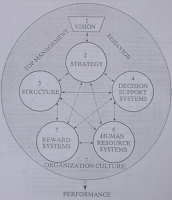 The focus of much of the evening was John Kotter's eight stages of change and the actions that could be taken to achieve each stage as brainstormed by the workshop participants.
The focus of much of the evening was John Kotter's eight stages of change and the actions that could be taken to achieve each stage as brainstormed by the workshop participants.The eight stages:
- Create a sense of urgency
- Create a guiding coalition
- Create a vision and strategy
- Communicate the change vision
- Empower broad-based action
- Generate short-term wins
- Consolidate and produce more change
- Anchor new approaches in the culture
"Introducing the customer-centered design approach at the appropriate phase in the change-management process was crucial to its adoption.The advisability of considering the larger framework of organizational and cultural change has been recognized by others as well.
... In order for the customer-centered approach to become institutionalized, the authors recognized that they needed to go beyond just changing practices in product design, and needed to affect changes to the organization structure, processes, and culture."
 For example, Don Fotsch, VP User Experience | Design & Product Planning at PayPal, keeps a handout at his desk which he received during a change management course he took when getting his MBA. The handout -- "Diagnosis for Organizational Design" by Robert Duncan -- describes a seven component design framework to help explain why an organization functions in the way it does, and provides guidance for analyzing how the seven components reinforce each other.
For example, Don Fotsch, VP User Experience | Design & Product Planning at PayPal, keeps a handout at his desk which he received during a change management course he took when getting his MBA. The handout -- "Diagnosis for Organizational Design" by Robert Duncan -- describes a seven component design framework to help explain why an organization functions in the way it does, and provides guidance for analyzing how the seven components reinforce each other."When considering change, all seven components must be considered, and if one is changed it is most likely that the other components will have to be changed to be consistent with each other."In an article entitled, "Connecting Cultures, Changing Organizations: The User Experience Practitioner as Change Agent," Paul Sherman wrote:
"As UX professionals, we have many tools and techniques available to us, and we contribute to our product teams in many ways. However, while having good UX skills is necessary, it is not alone sufficient. No matter the size of our organizations or the domains we work within, our most valuable contributions are not our design or user research efforts. Rather, our most valuable contributions occur when we function as change agents."And during the session I led at CHI 2007 entitled, "Moving UX into a Position of Corporate Influence: Whose Advice Really Works?", Secil Watson's concluding remarks included:
"Think of yourselves as change agents. If you like that role, then look at of yourselves as the people who can really change the culture of the organization you are a part of."(Secil is Senior VP of Internet Channel Strategy at Wells Fargo.)
However, I recently read an entry in someone's blog -- which, unfortunately, I'm unable to locate again -- which argued that user experience professionals should NOT reveal their intent to change an organization's culture, since doing so will increase the resistance they are likely to face. This argument reminded me of a 1995 article in Communications of the ACM entitled, "Succeeding as a Clandestine Change Agent," in which C. Dennis Allen wrote:
"This was my challenge: to change a development organization of hundreds of software engineers without letting them know it. The goal is the success of the organization, not necessarily to receive credit for your own contributions. ... Since talking directly to upper management had failed in my previous situation, I decided I would try a longer term, grass-roots strategy. ... I wanted to avoid the risks of cross-organizational antagonism that often leads to failure when one group is trying to 'fix' another group in the company."
However, in today's world, I'm not sure it remains as advisable to be clandestine and to not talk directly with upper management. Today, openness and enlisting everyone's support as well as their participation has a greater chance of success and might very well speed up a process which in many organizations has taken many years to achieve, some of which your company might not be able to wait.
